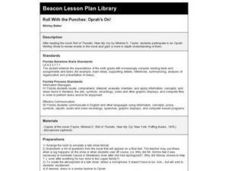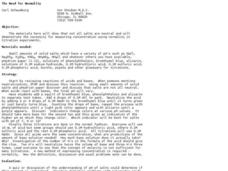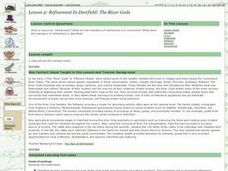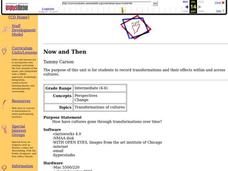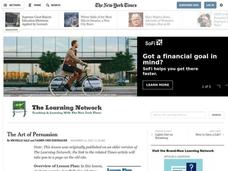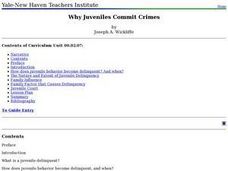Curated OER
Lemonade Stand: Making Money the Old-Fashioned Way
Students run their own lemonade stand and are to figure out what to sell the lemonade at to gain the maximum profit.
Curated OER
Yin Yang
Students apply yin and yang characteristics in sketches of clothing. They observe a PowerPoint presentation, discuss the characteristics of yin and yang and then apply their knowledge of the content to fashion sketches. They rate...
Curated OER
Historical Witness - social Messaging
Students examine and develop artwork that shows women's roles during different eras. For this women's role lesson, students look at artwork that shows women at work during the mid-nineteenth to early twentieth century. They design a...
Curated OER
Roll With the Punches: Oprah's On!
Sixth graders prepare questions for an Oprah Winfrey talk show featuring the characters from Roll of Thunder, Hear My Cry, the amazing novel by Mildred D. Taylor. Selected students role-play the characters and answer questions Oprah...
Curated OER
The Need for Normality
Students investigate the need for measuring concentrations in normality in titrations. In this titrations and normality lesson plan, students perform titrations and use different indicators to show they change colors at different pH...
Curated OER
Lunar Lollipops
Students simulate the phases of the moon using a lamp and styrofoam balls. In this lunar phases lesson, students stand around a lamp and act as Earth. They hold styrofoam balls and rotate to show the phases of the moon.
Curated OER
Refinement in Deerfield: The River Gods
Students research the town of Deerfield, CT and its River God families to show how the middle class developed in the Connecticut River Valley.
Curated OER
You Are What You Wear
Students, after analyzing interactions between groups/societies, effects of causality/change over time, forms of imaginative writing and utilizing art media to conveying messages/meaning, examine the relationship between clothing and...
Curated OER
Now and Then
Students record transformations and their effects within and across cultures. Students study the life of specific people in a former time period and then in the present time period. This teacher focused on the Winnebago tribe, using her...
Curated OER
Rocket Science
Learners conduct an experiment. In this physical science lesson, students learn about Isaac Newton's theory that for every action there is an equal but opposite reaction. Learners show this theory by looking at how a rocket is propelled...
Curated OER
A Biblical Perspective
Students analyze money using a Biblical and business perspective. In this algebra lesson, students define their money relationship biblically and in a business fashion. They compare their view with the view of someone in the Gold Rush days.
Channel Islands Film
Lone Woman of San Nicolas Island: Lesson Plan 4
Imagine being stranded all alone on an island for 18 years. How would you survive? Class members are challenged to makes necessities out of natural materials that would likely be found on an island.
Curated OER
Guidance for Creating Reading Lessons for Dyslexic Students
Here are a few practical tips and sound strategies you can use in writing effective reading lessons for your pupil with dyslexia. The resource provides simple guidelines and accommodations that can be incorporated into any lesson that...
Social Media Toolbox
Social Media Roles
Social media has changed the news publishing process, so how does it affect school news publications? Lesson nine in a 16-part series titled The Social Media Toolbox explores the traditional publishing roles through the lens of social...
Curated OER
Writing Process
Test students on what they know about the writing process and general grammar terms. The game is fashioned after the "Jeopardy" quiz show, where the answer is phrased in the form of a question. There are 25 questions and answers.
Curated OER
Torn Paper Collage Portrait
Students watch demonstrations on how to create a collage out of different materials. Using town paper, they create their self-portrait and view art by Andy Warhol and Roy Lichtenstein. To end the instructional activity, they discuss a...
Curated OER
Rock n' Rollin in the '50s
Young scholars explore the culture of the United States in the 1950's. In this history lesson, students research culture in the 1950's, with a focus on fashion, music, television, automobiles, etc., then work in groups to create a...
Curated OER
The Art Of Persuasion
Students engage in a lesson plan that focuses upon the use of persuasive speech. They conduct research into the famous sayings used by sideshow owners and performers from the Old West. Students then create advertisements for shows that...
Curated OER
Leisure Time
Students write about and discuss personal leisure time activities and record their activities in a slide show format to present to their classmates. They work off a word bank of materials relating to fly-tying and fishing after all other...
Curated OER
Diggin' The Past
Students explore the culture of Ancient Egypt. For this ancient civilizations lesson, students are divided into groups to research how aspects of culture were influenced by the Nile River. Students create a slide show that describes how...
Curated OER
Students Exploring Cyberspace (SECs) Project
Students study AIDS and other current topics in a multinational, interdisciplinary fashion. They communicate with students from other countries throughout e-mail to find out how AIDS impacts other societies.
Curated OER
Popsicle Stick Kids
Students use popsicle sticks to make different characters. They use fabric to make the clothes and even place eyes to make them seem more real. They add jewelry and any other fashion item to complete the character.
Curated OER
Why Juveniles Commit Crimes
Students examine the reasons why juveniles commit crimes. As a class, they watch movies showing juveniles committing crims and discuss the impact on societies. They take a field trip to adult and juvenile courts and compare their...
Curated OER
Art and Anatomy: The Vitruvian Teen
Learners are introduced to the history of showing the human anatomy. In groups, they measure their height and arm spans to create a graph and determine if their measurements support Vitruvius' work. Individually, they make their own...





